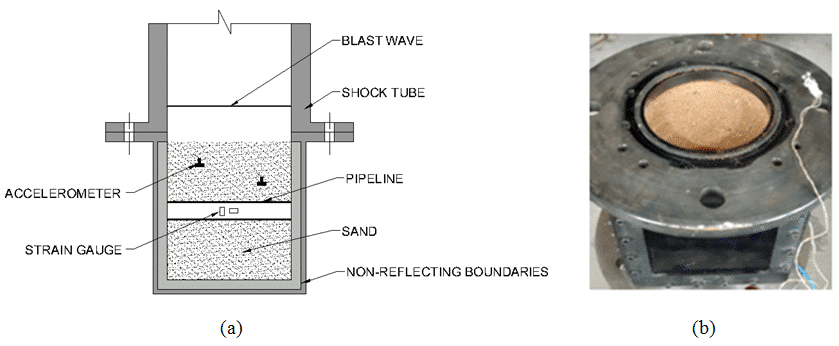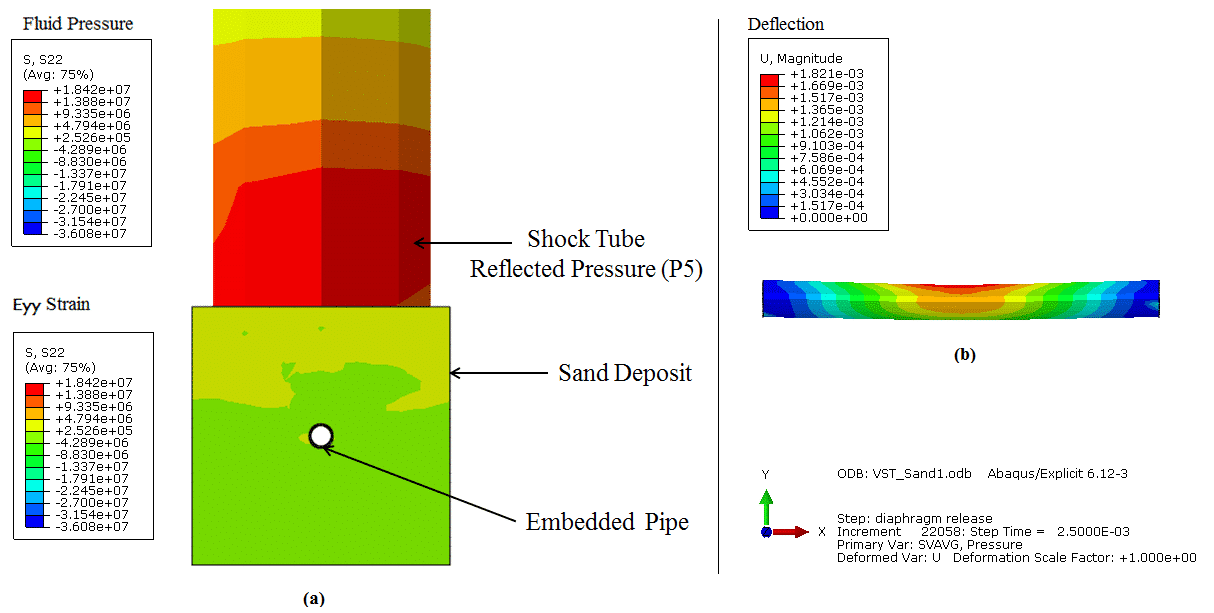Due to various catastrophic accidents and increasing terrorist activities in recent years, there has been a considerable interest in studying structures exposed to explosive loads. The stability of underground structures like bunkers, tunnels and pipeline networks are crucial under blast loading. This study emphasizes mainly to the underground pipelines which are used to transport oil and gas. The work presented here aims at investigating the behavior of a small-scale embedded pipe subjected to surface blast loading.
Extensive work has been performed on blast induced effects on buried pipelines and most of the studies are focused on developing analytical expression (Kouretzis, 2007) and numerical studies (Lu, 2005). However, very few experimental studies have succeeded in the past, due to the limitation of using explosives. The use of explosives in laboratory is a complex phenomenon, due to the lack of repeatability conditions and safety concerns. Shock tube is used here to generate repeatable blast wave under controlled conditions and it is also correlated against the quantity of TNT charge placed at known distance. The initial set of shock tube experiments aim at investigating the dynamic soil parameters upon a shock wave impact. A set of accelerometers and pressure gauges are buried in the soil deposit to capture the vibrations and the attenuation of the pressure waves developed in the soil. Upon determining the dynamic soil characteristics, mild steel or aluminum pipe is embedded in the soil chamber and the shock tube experiments were carried out. The pipe embedded in the soil is exposed to surface blast of varied strengths of desired equivalent blast wave parameters. Soil-structure interaction response is captured by mounting a couple of strain gauges along circumferential and longitudinal direction of the pipe. A schematic diagram of the experimental setup is shown in the Fig 1.

Fig. 1: (a) Schematic cross section of the experimental setup (b) Sand layer deposit in a confined chamber
Though, the present work focused mainly on the experimental approach, finite element results were compared with the experiments to show the authority of numerical simulation of shock/blast impact on granular materials like soil. A Coupled Eulerian-Lagrangian (CEL) Analysis was performed using Finite element package, Abaqus/Explicit. The shock tube is modeled with Eulerian elements, while the sand is modeled as continuum medium using Drucker-Prager linear model and pipe is modeled using linear elastic model. A coupled analysis is performed to determine the soil-structure interaction response. The strain contours experienced by the soil profile and the deflection of the pipe is shown Fig. 2. The experimental and numerical results from this study will help in evaluating the response of the pipeline during an explosion and further aid in developing and designing a blast resistant pipeline structure. Details of these studies along with the important observations will be presented in the full length paper.

Fig. 2: Results of numerical simulation using Coupled Eulerian Lagrangian method (a) Strain distribution on the soil deposit (b) deflection profile of the pipe
Keywords: Shock tube, Blast Wave, Pipeline, Soil–Structure Interaction
References
Kouretzis GP, Bouckovalas GD and Gantes CJ. (2007). Analytical calculation of blast-induced strains to buried pipelines. International Journal of Impact Engineering; 34(10):1683–1704.
Lu Y., Wang Z. and Chong K. (2005). A comparative study of buried structure in soil subjected to blast load using 2D and 3D numerical simulations. Soil Dynamics and Earthquake Engineering, 25:275–288.

